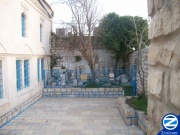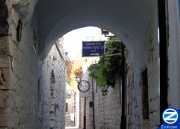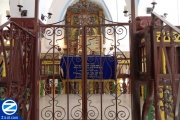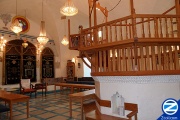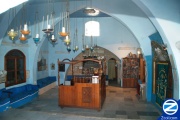Tzfat Synagogues
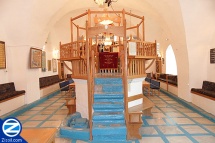 | |
| Hebrew: | |
|---|---|
| בתי כנסת בצפת | |
| Other Names: | |
| Tzfat Shuls, Bati Kneset | |
| Description: | |
| Ancient, Old and Modern Jewish places of worship in Safed, Israel. |
The famous synagogues of Safed encompass Tzfat history alongside Kabbalistic tradition. Some of the most famous synagogues include the Ari Ashkenazi, Ari Sephardi, Avritch, Abuhav, Beirav, Yoseph Caro and the Yossi Banai. These synagogues are all located in the Old Jewish Quarter of Tzfat. They are all functioning synagogues and have regular prayer times.
Contents |
[edit] Old Synagogues
[edit] Abuhav
Rabbi Yitzchock Abuhav was a Spanish Rabbi who's students immigrated to Tzfat at the end of the 15th century, immediately after the Jews were expelled from Spain. Tsfat legend mentions that Rabbi Abuhav built the Abuhav Synagogue in Spain and his students mystically transported it to Tzfat when they came to Israel. Others adhere to the tradition that Rabbi Abuhav planned the synagogue in Spain and it was built by his followers upon their arrived in Israel. Rabbi Abuhav hand-wrote a Torah scroll which is still used in the synagogue on special holidays. The synagogue was originally built near the ARI Sepharadi synagogue but after it was destroyed in the 1759 earthquake, survivors rebuilt the synagogue higher up on the mountain, in its present location between Abuhav and Alkabetz Streets. Others maintain that had always been its location. In 1837 an earthquake again destroyed the synagogue but the Ark, holding Rabbi Abuhav’s ancient Torah scroll as well as two other old scrolls, did not collapse. The synagogue was rebuilt surrounding this original southern wall. During the Second Lebanon War in 2006 a katyusha rocket landed directly next to the synagogue alongside the southern wall but again, the Ark and its Torah scrolls were untouched.![]() Read full Zissil article on the Abuhav Synagogue
Read full Zissil article on the Abuhav Synagogue
[edit] Alsheich Synagogue
One of the oldest Shuls in Tzfat, the Alsheich Synagogue was the only one not destroyed in the 1759 or 1837 earthquakes. Its construction was led by Rabbi Moshe Alshich and his congregation of immigrants from Turkey. This Beit Knesset was built without a women's section or restrooms for higher levels of purity. Some point to this as the reason it survived the earthquakes. It was renamed after the Alshich when he passed away.![]() Read full Zissil article on the Alsheich Synagogue
Read full Zissil article on the Alsheich Synagogue
[edit] ARI Ashkanazi
The ARI Ashkanazi synagogue is located along the Ma’alot Gur Aryeh stairway that descends from the main public square of Tzfat’s Old City, “Kikar HaMeginim -- Defender’s Square.” The synagogue was originally called the “Grigoros Synagogue,” established by Sepharadi Jews who arrived in Tzfat from the Greek island of Grigoros after escaping the Spanish Inquisition. Rabbi Isaac Luria, the great Kabbalist known as The ARI, initiated the tradition of “Kabbalat Shabbat,” in Tzfat. He would welcome the Sabbath by singing and dancing with his students in the field next to the Grigoros shul, which at the time stood at the cities edge. After The ARI died the synagogue was renamed “ARI Ashkanazi” in honor of The ARIZ'L. Childless couples consider it a segula to sit in the shul's Chair of Eliyahu.![]() Read full Zissil article on the Ari Ashkenazi Synagogue
Read full Zissil article on the Ari Ashkenazi Synagogue
[edit] ARI Sepharadi
The ARI Sepharadi is the oldest standing synagogue in Safed, although it was rebuilt after both the 1759 and 1837 earthquakes. It is perched on the road above the ancient Safed cemetery and overlooks the cemetery and surrounding valley. This synagogue was called the “Eliyahu Hanavi” (Elijah the Prophet) shul when the ARI came to live in Tzfat in the 16th century. The ARI prayed and studied in the synagogue, sitting with Elijah the Prophet in a small room within the synagogue as he expanded on the existing knowledge of Kabbalah through Divine Inspiration. After the ARI’s passing the residents of Tzfat renamed the synagogue “ARI Sepharadi” in honor of the ARIZAL.![]() Read full Zissil article on the Ari Sephardi Synagogue
Read full Zissil article on the Ari Sephardi Synagogue
[edit] Joseph Caro
The Yosef Caro Synagogue is housed in the location of the former Tzfas Beit Din where Rabbi Joseph Caro served as Av Beis Din. Rabbi Yosef Caro came to Tzfat in the early 1500's from Turkey, where his family had escaped to from the Spanish Inquisition. He authored the Shulhan Aruch and the Beit Yosef, some of his writing was done in a room located underneath the Karo Synagogue. Later the Rabbinical Court was turned into a study hall. Destroyed in the 1837 earthquake, the Karo Shul was rebuilt by Italian philanthropist Isaac Guetta. It contains several old Sefri Torah and a 'Geniza' section of ancient manuscripts. On Shabbos, the Caro Shul operates Sephardi minyanim and during the week it is open to tourists.![]() Read full Zissil article on the Yosef Caro Synagogue
Read full Zissil article on the Yosef Caro Synagogue
[edit] Avritch / Bat Ayin
The Avritch synagogue, close to the northern perimeter of the Old Jewish Quarter, is also called the “Bat Ayin” shul. Rabbi Dov who arrived from Avritch, a town in the Ukraine, led his Hassidic followers in this synagogue. In 1837, during morning prayers, Rabbi Dov suddenly called his followers to come and stand next to him at the front wall. As the men rushed to their rabbi, a strong earthquake struck the city. Close to a fourth of the city’s citizens died but all the men at the synagogue survived. Many members of the Avritch community left Tzfat over the years and since the late 1800s the shul has had a Sepharadi minyan.
![]() Read full Zissil article on the Avritch Bat Ayin Synagogue
Read full Zissil article on the Avritch Bat Ayin Synagogue
[edit] Beirav
Rabbi Ya’akov Beirav lived in Tzfat in the 16th century. He was best known for his efforts to re-establish the Sanhedrin, the Jewish court of the Temple era. During Rabbi Beirav’s lifetime many Jews who had converted to Christianity under the Inquisition escaped from Spain and Portugal. They made their way to Jewish communities where they tried to return to the faith of their ancestors. A large number of Jewish leaders refused to accept these returnees, arguing that by converting to Christianity they forfeited their claim to Judaism. Rabbi Beirav believed that a Sanhedrin would provide the authority to convince the Jewish leadership to welcome these Jews back to Judaism. Ultimately, Rabbi Beirav was not successful in his endeavors to establish the Sanhedrin, but together with Rabbi Moshe Alsheich, also of Safed, his view, to accept the returnees back into the Jewish community, prevailed.
The Beirav shul in Tzfat presently houses a Shlomo Carlebach minyan. The Beirav services have a reputation as being a lively and engaging Friday night service. Shlomo Carlebach, the “singing rabbi,” was known, until his death in 1996, for drawing Jews closer to Judaism through heartfelt song and prayer. His unique tunes are sung each Friday night at the Beirav synagogue, creating a standing-room-only crowd that sings, sways, dances and prays together. Many people who otherwise have little or no connection to Judaism find themselves drawn to their heritage at the synagogue named for the Rabbi who, 400 years ago, championed acceptance.
![]() Read full Zissil article on the Beirav Synagogue
Read full Zissil article on the Beirav Synagogue
[edit] Yossi Banai
The Banai synagogue is located at the base of the Old Jewish Quarter. It contains the grave of the 3rd century sage, Yossi Banai. The synagogue is also called the “Tzadik HaLavan” because of a miracle performed in the name of Rabbi Yosef Banai. During the time of Turkish rule, the local Turkish ruler decreed that if the Jews did not bring a large number of white chickens, they would be forced to pay a large collective fine. The impoverished Jewish community prayed at the grave of R’ Banai and Rabbi Yossi Saragosi. When the community awoke the following morning they found that all their chickens had turned white.
![]() Read full Zissil article on the Yossi Banaah Synagogue
Read full Zissil article on the Yossi Banaah Synagogue
[edit] Hassidic Synagogues
Tzfat has traditionally had a Hassidic population but in recent years a number of Hassidic Jews have established large communities in the city. They welcome Jews to their synagogues to join them in prayer.
[edit] Sanz Shul
The Sanz synagogue on Tarpat Street has continuous minyans for all prayer times throughout the day.
![]() Read full Zissil article on the Sanz Shul
Read full Zissil article on the Sanz Shul
[edit] Tzmeach Tzedek
The Chabad community’s Tzmeach Tzedek synagogue near Kikar HaMeginim has mid-morning services for late-risers and learning sessions throughout the day.
![]() Read full Zissil article on the Tzemach Tzedek Shul
Read full Zissil article on the Tzemach Tzedek Shul
[edit] Koenig Breslov Shul
The large Breslev synagogue near the ARI Sepharadi has daily prayer minyans and a song-filled Friday night service.
[edit] Kosov Shul
Origionaly founded by Kosov Chasidim it is now run by followers of the Biala Rebbe.
![]() Read full Zissil article on the Kosov Shul
Read full Zissil article on the Kosov Shul
[edit] Modern Synagogues
[edit] Noam Synagogue
Hosted in the Saraya.
![]() Read full Zissil article on the Noam Synagogue
Read full Zissil article on the Noam Synagogue
[edit] Mekarav Synagogue
Originally a chasidic shul, it is now run by some local yeshiva.
![]() Read full Zissil article on the Mekarav Synagogue
Read full Zissil article on the Mekarav Synagogue
[edit] House of Love and Prayer
A break off from the Beirav Minyon, it also runs according to Carlebach tradition.
![]() Read full Zissil article on the House of Love and Prayer
Read full Zissil article on the House of Love and Prayer
| |||||||||||
| |||||||||||||||||
| ||||||||||||||


